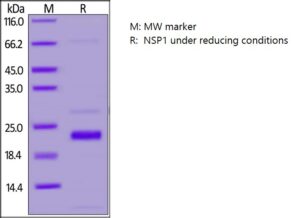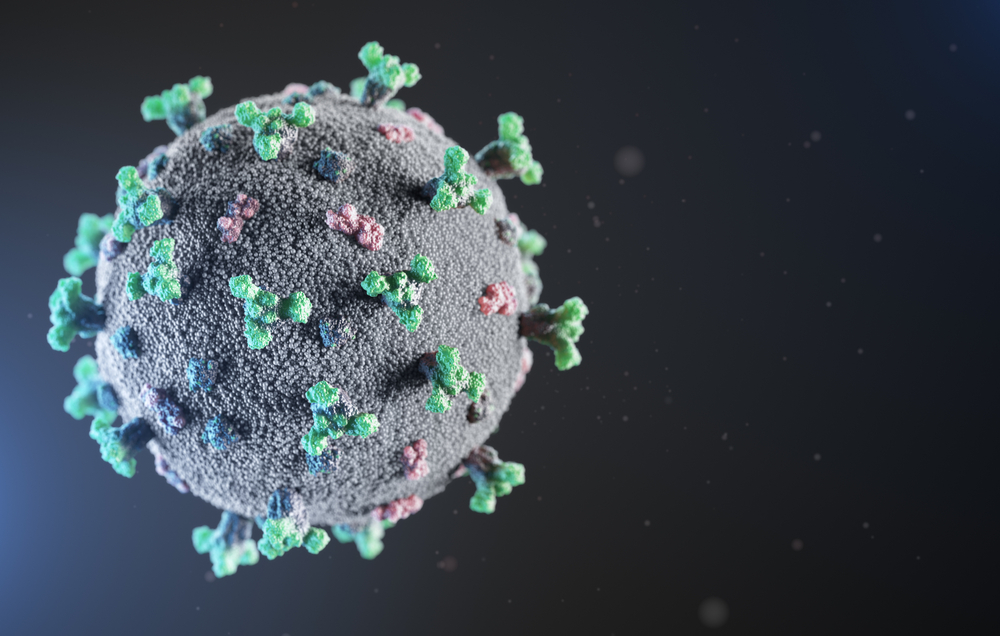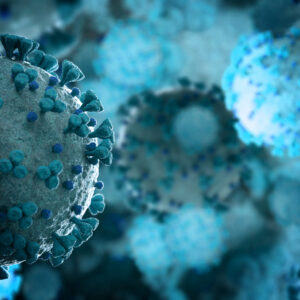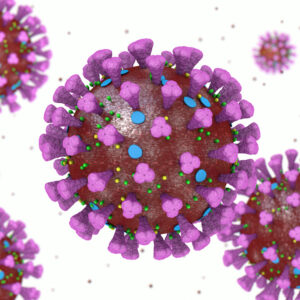
SDS-PAGE: Coomassie-stained reducing SDS-PAGE showing purified NSP1.
SARS-CoV-2 NSP1 Protein, His-Tag (E. coli)
$1,339.01 excl. VAT
SARS-CoV-2 NSP1 protein, His-tag is a recombinant viral protein expressed in E. coli. SARS-CoV-2, previously known as the 2019 Novel Coronavirus (2019-nCoV), causes the pandemic COVID-19 disease.
SARS-COV-2 NSP1, HIS-TAG (E. COLI)
SARS-CoV-2 NSP1 protein, His-tag is a recombinant viral protein expressed in E. coli. SARS-CoV-2, previously known as the 2019 Novel Coronavirus (2019-nCoV), causes the pandemic COVID-19 disease.
PRODUCT DETAILS – SARS-COV-2 NSP1, HIS-TAG (E. COLI)
- SARS-CoV-2 NSP1 protein, His-tag.
- Expressed in E. coli cells with an C-terminal His-tag and >90% purity.
- Presented lyophilized from 0.22 μm filtered solution in PBS, Arginine, pH7.4.
BACKGROUND
In December 2019 a novel coronavirus, severe acute respiratory syndrome coronavirus 2 (SARS-CoV-2), formerly known as the 2019 novel coronavirus (2019-nCoV) was identified in Wuhan, China, causing a world-wide pandemic (Wu et al., 2020). Three coronaviruses, SARS-CoV, MERS-CoV, and SARS-CoV-2 have been identified as being a highly pathogenic for humans, and there is currently no effective antiviral treatment. Therefore, studies are focused on rapid development of vaccines and antiviral drugs to prevent and treat coronavirus infection. There are several potential strategies to pharmacologically fight against the disease (COVID-19), including vaccines, monoclonal antibodies, oligonucleotide-based therapies, peptides, interferon therapies, and small-molecule drugs (Dömling & Gao, 2020).
The viral nonstructural protein 1 (nsP1) is the only membrane-associated protein that anchors the replication complex to the cellular membranes. NSP1 inhibits host translation by interacting with the 40S ribosomal subunit. The nsp1-40S ribosome complex further induces an endonucleolytic cleavage near the 5’UTR of host mRNAs, targeting them for degradation. Viral mRNAs are not susceptible to nsp1-mediated endonucleolytic RNA cleavage thanks to the presence of a 5′-end leader sequence and are therefore protected from degradation. By suppressing host gene expression, nsp1 facilitates efficient viral gene expression in infected cells and evasion from host immune response (Lapointe et al., 2021; Semper et al, 2021).
REFERENCES
- Dömling A, Gao L. Chemistry and Biology of SARS-CoV-2. Chem. 2020;6(6):1283-1295.
- Lapointe CP, Grosely R, Johnson AG, Wang J, Fernández IS, Puglisi JD. Dynamic competition between SARS-CoV-2 NSP1 and mRNA on the human ribosome inhibits translation initiation. Proc Natl Acad Sci U S A. 2021 Feb 9;118(6):e2017715118.
- Semper C, Watanabe N, Savchenko A. Structural characterization of nonstructural protein 1 from SARS-CoV-2. iScience. 2021 Jan 22;24(1):101903.
- Wu F. et al: A new coronavirus associated with human respiratory disease in China. Nature 579: 265-269, 2020.




